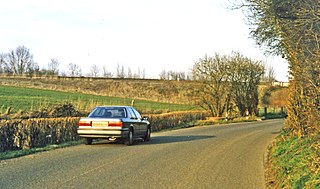Related Research Articles

Reedham railway station is in the south of Purley in the London Borough of Croydon on the Tattenham Corner line. The local area is residential and the station is near the A23 Brighton Road. It is 15 miles 65 chains (25.4 km) measured from London Charing Cross. The Brighton Main Line is adjacent, but is not served by this station.

The East Coastway line is a railway line along the south coast of Sussex to the east of Brighton, England. Trains to the west of Brighton operate on the West Coastway line. Together with the West Coastway and the Marshlink line to the east, the line forms part of a continuous route from Havant to Ashford. The Brighton Main Line route to Eastbourne and Hastings, via Plumpton and Cooksbridge, shares the East Coastway line east of Lewes station.

Queenborough railway station is on the Sheerness Line, on the Isle of Sheppey in northern Kent, and serves the town of Queenborough. It is 49 miles 22 chains (79.3 km) down the line from London Victoria.

Highley railway station is a station on the Severn Valley Railway heritage line in Shropshire, near the west bank of the River Severn and just under a mile south-east of the village of Highley. Highley is the only staffed single-platform station on the line. Other stops with one platform are unstaffed halts.

Grove Ferry and Upstreet was a railway station in east Kent. It was opened by South Eastern Railway (SER), on the Ashford to Ramsgate line between Sturry station and Minster station.
There are eight disused railway stations between Wadebridge and Bodmin North on the former Bodmin and Wadebridge Railway in Cornwall, in the United Kingdom, with ten other closed sidings on the branches to Ruthern Bridge and Wenfordbridge. The section from Boscarne Junction to Bodmin General is currently part of the Bodmin and Wenford Steam Railway; the line from Wadebridge to Wenfordbridge is now part of the Camel Trail, and the line to Ruthern Bridge can be followed for much of its length as it runs parallel to a public road.
Milton Range Halt was a halt between Denton Halt and Hoo Junction Staff Halt on the Hundred of Hoo Railway. It opened in July 1906 and closed to public use on 17 September 1932, although it remained open by special arrangement after that date until some time after 1956. It served Milton Range rifle range.

Yarnton Junction was a three-platform station serving the village of Yarnton, Oxfordshire. It was built in 1861 at the junction of the Oxford, Worcester and Wolverhampton Railway and Witney Railway, north of Oxford. British Railways closed the station to passengers in 1962 and it was demolished c. 1965.

Carno is a closed railway station in Carno, on the Cambrian Line, that was part of the Newtown and Machynlleth Railway. The station was closed in 1965 as part of the Beeching Cuts though there are proposals to re-open it.

Seaton railway station served the village of Seaton, near Workington in Cumberland, England.
Six Bells Halt railway station was a station which served the Six Bells Colliery near Abertillery in the Welsh county of Monmouthshire.

Bournville (Mon) Halt railway station was a station which served Ty'r-Cecil near Blaina Abertillery in the Welsh county of Monmouthshire.

Hothfield railway station was a railway station on the Maidstone Line at Hothfield, Kent. It was situated between Ashford and Charing stations. The station opened in 1884; it closed to passengers in 1959 and general freight in 1964 although the sidings continued to be used for deliveries of aggregate traffic.

Camerton Colliery Halt railway station was an unadvertised halt for workers at one or both of the collieries at Camerton, near Cockermouth in Cumberland, England.

Buckhill Colliery Halt railway station was an unadvertised halt for workers at Buckhill Colliery north east of Camerton, near Cockermouth in Cumberland, England.

Holland Road Halt was a railway station in Hove, East Sussex, which opened in 1905 and closed in 1956. It lay to the west of the original Hove station (1840–1880) and to the east of the current station of that name (1865–present) as well as the Cliftonville Curve. It was mainly used during rush hours by stopping trains to Worthing.
Richborough Castle Halt was a minor station on the Kent Coast Line. It opened in 1918 for military use. Public services began in 1933, lasting until 1939 when the halt was closed.
Headcorn Junction railway station was the Kent and East Sussex Railway's northern terminus. It was adjacent to the South Eastern and Chatham Railway's Headcorn station. It opened in 1905 and closed in 1954.
Tankerton Halt was a minor station on the Canterbury and Whitstable Railway at Tankerton, Kent. It opened in 1914 and closed in 1931.
South Street Halt was a minor station on the Canterbury and Whitstable Railway at Tankerton, Kent. It opened in 1911 and closed in 1931.
References
- Citations
- ↑ Quick, Michael (2022) [2001]. Railway passenger stations in Great Britain: a chronology (PDF). version 5.04. Railway & Canal Historical Society. p. 131.
- ↑ Mitchell & Smith 1995, Illustration 59.
- 1 2 Mitchell & Smith 1995, Chislet Colliery.
- ↑ Mitchell & Smith 1995, Illustrations 59 & 60.
- 1 2 Mitchell & Smith 1995, Illustration 61.
- ↑ Kidner 1985, p. 43.
- ↑ Mitchell & Smith 1995, Illustration 60.
- Sources
- Kidner, R. W. (1985). Southern Railway Halts. Surve and Gazeteer. Headington: The Oakwood Press. ISBN 0-85361-321-4.
- Mitchell, Vic; Smith, Keith (1995). Branch Lines Around Canterbury. Midhurst: Middleton Press. ISBN 1-873793-58-8.